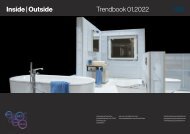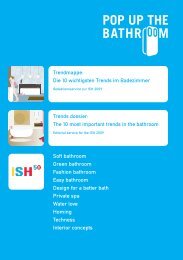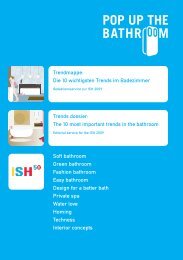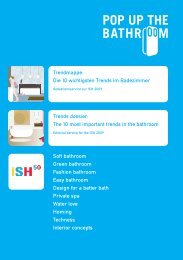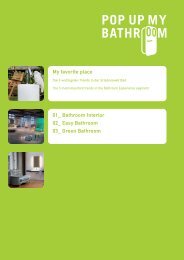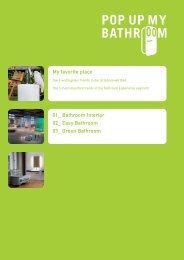My favorite place - Trendbook Pop up my Bathroom | Issue 01/2011 ISH 2011
Today’s bathrooms are no longer chilly, wipe-clean functional cells. Bathrooms are turning into living space. As simple as this meanwhile ubiquitously manifest megatrend might sound, its impact on the sanitary industry and the conceptual possibilities for bathroom design are nothing short of revolutionary. As a result, expectations of the aesthetics and functionality of contemporary bathroom design are growing. Accordingly, there will be more than “just” new products on show at the world’s leading fair for the sanitary industry, the ISH in Frankfurt. For it is not the bathtub that is being reinvented, but the entire bathroom.
Today’s bathrooms are no longer chilly, wipe-clean functional cells. Bathrooms are turning into living space. As simple as this meanwhile ubiquitously manifest megatrend might sound, its impact on the sanitary industry and the conceptual possibilities for bathroom design are nothing short of revolutionary. As a result, expectations of the aesthetics and functionality of contemporary bathroom design are growing. Accordingly, there will be more than “just” new products on show at the world’s leading fair for the sanitary industry, the ISH in Frankfurt. For it is not the bathtub that is being reinvented, but the entire bathroom.
Create successful ePaper yourself
Turn your PDF publications into a flip-book with our unique Google optimized e-Paper software.
alleine schon durch ihre Vielfalt an Schrankelementen,<br />
Oberflächen, Maßen und Ausstattungsvarianten<br />
von der Stand-, Wand- oder Deckenbis<br />
zur Aufsatzarmatur zu raumbildenden<br />
Arrangements kombiniert werden können,<br />
fallen auch Produktkonzepte auf, die ganz allein<br />
den Schritt von der Wand weg wagen und ihren<br />
eigenen Raum bilden, so wie etwa die Spiegelschrankwand<br />
Edition Atelier (Keuco). Auch die<br />
Mirrorwall (Duravit), die an sich schon ein Hingucker<br />
ist, schafft sich ihren eigenen Raum, der<br />
sich mit Öffnen der Türen vor und hinter den<br />
Waschbecken zu bilden scheint – vor allem dank<br />
optischer Effekte. Endgültig ins Reich architektonischer<br />
Bauelemente stößt das Schranksystem<br />
rc 40 (Burgbad) vor, das ein modulares<br />
System für vielfältige Raumaufteilungen bietet.<br />
Mit begehbaren Schränken, Waschtischen und<br />
Konsolen vermittelt rc 40 zwischen Architektur,<br />
Möbel und Sanitärobjekten. Und mit Sauna-<br />
Konzepten wie Inipi (Duravit) werden sogar<br />
ganze Räume, die einst im Keller standen, im<br />
Bad-Wohn-Bereich integriert.<br />
Ursprünglich wollte Design die Produktwelt<br />
menschlicher machen – mit Hilfe der Ergonomie.<br />
Sie sucht die dingliche Umwelt dem menschlichen<br />
Körper anz<strong>up</strong>assen. Bei den Raumkonzepten<br />
für das Bad wird nach individuelleren<br />
Lösungen gesucht – hier wird die Raumaufteilung<br />
den Gewohnheiten und Idealvorstellungen<br />
Einzelner angepasst. Die professionelle<br />
Planung des Bades wird daher in Zukunft an<br />
Bedeutung gewinnen. Der Badplaner wird zum<br />
Regisseur, der die Objekte inszeniert und vorgibt,<br />
wie der Mensch sich zwischen ihnen bewegen<br />
und wie er das Bad nutzen kann. Die<br />
räumliche Qualität des Bades wird dabei durch<br />
zwei gleichwertige Parameter bestimmt: zum<br />
einen durch die Gestaltung des Ambientes und<br />
die dramaturgische Wirkung von Formen, Farben,<br />
Materialien und Licht; zum anderen durch<br />
die räumliche Strukturierung mittels gezielt<br />
platzierter Sanitärobjekte. Um diese herum bildet<br />
sich aufgrund des benötigten Bewegungsspielraums,<br />
durch optische Differenzierung<br />
und/oder bauliche Elemente und Raumteiler<br />
ein „Hof“ – eine Nutzungszone.<br />
Auch im Bad werden heute die Wege zwischen<br />
den einzelnen Stationen analysiert. Aber es<br />
geht dabei nicht in erster Linie um Effizienz,<br />
sondern um Aufenthaltsqualität und eine bedarfsabhängige<br />
Zonierung des größer gewordenen<br />
Platzangebots. Körperpflege wurde in<br />
unserem Lebensstil aufgewertet, da sie nicht<br />
nur der Hygiene dient, sondern auch dem<br />
Genuss und der Entspannung. Als wertvoller<br />
14<br />
mainly due to visual effects. The rc 40 cabinet<br />
series by Burgbad, a modular system that<br />
permits a wide variety of layouts, has stepped<br />
into the realm of architectural structuring<br />
elements once and for all. With walk-in<br />
c<strong>up</strong>boards, washstands and consoles, rc 40<br />
mediates between the architecture, furniture<br />
and sanitaryware. And with sauna concepts<br />
like Inipi (Duravit), even entire rooms that are<br />
traditionally housed in the basement can be integrated<br />
into the bathroom-cum-living-space.<br />
Originally design wanted to make the product<br />
world more human – with the aid of ergonomics.<br />
It tries to adapt our material surroundings<br />
to the human body. Today’s interior concepts<br />
for the bathroom seek more individual<br />
solutions – the floor plan is adapted to the habits<br />
and ideals of the specific user. As a result,<br />
professional bathroom planning is set to become<br />
increasingly important. The bathroom planner<br />
is becoming a director who stages the objects<br />
and specifies how the occ<strong>up</strong>ant moves around<br />
between them and how he can use the bathroom.<br />
The spatial quality of the bathroom is determined<br />
by two equally important parameters: firstly by<br />
the design of the atmosphere and the dramaturgical<br />
effect of the forms, colours, materials<br />
and lighting; secondly by the spatial<br />
structuring achieved by means of deliberately<br />
positioned sanitaryware. In order to ensure<br />
the required freedom of movement, a “courtyard”,<br />
or usage zone, is built around them by means<br />
of visual differentiation and/or structural<br />
elements.<br />
Today the paths between individual locations<br />
in the bathroom are being analysed as well.<br />
However, it is not primarily a question of<br />
efficiency but of the quality of the experience<br />
and the needs-based zoning of the increased<br />
space available. Grooming enjoys enhanced<br />
status in our lifestyle because it not only serves<br />
hygienic purposes but provides enjoyment and<br />
relaxation as well. As a valuable component of<br />
our culture, grooming is being differentiated<br />
into various sub-functions – such as washing,<br />
cleansing and refreshing, facial and beauty<br />
care, daily routines, switching off and relaxing,<br />
dressing and even fitness or socialising.<br />
Text: Claudia Wanninger



